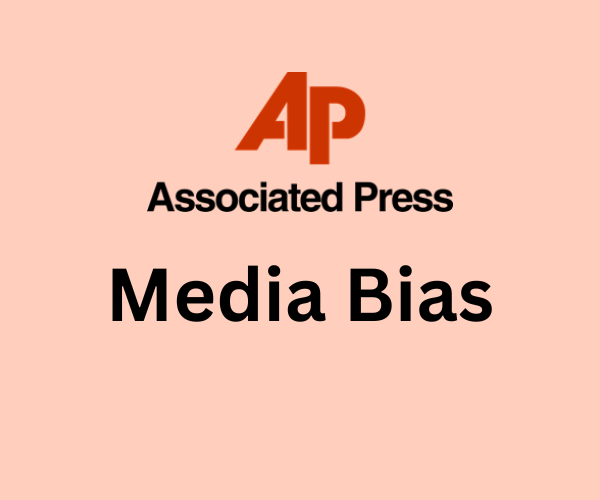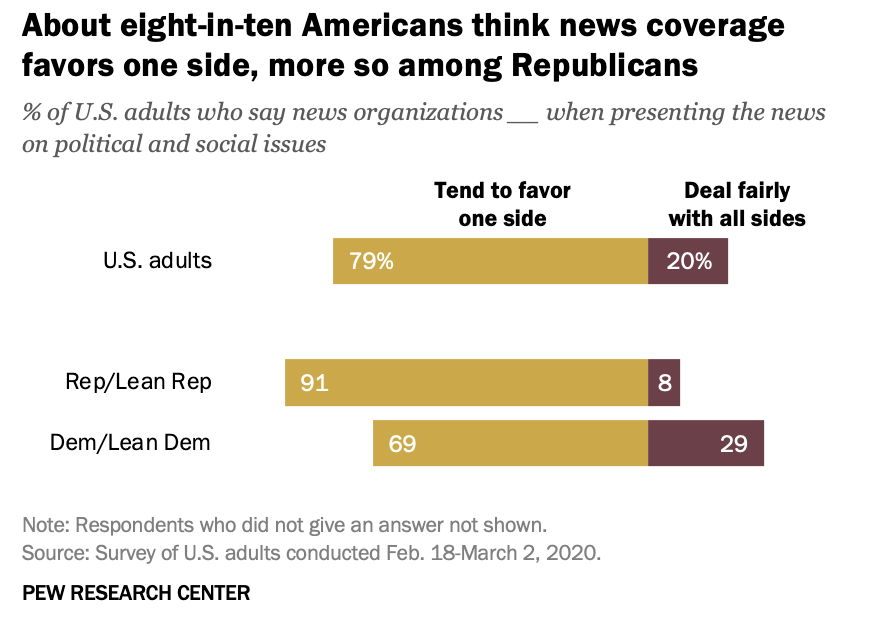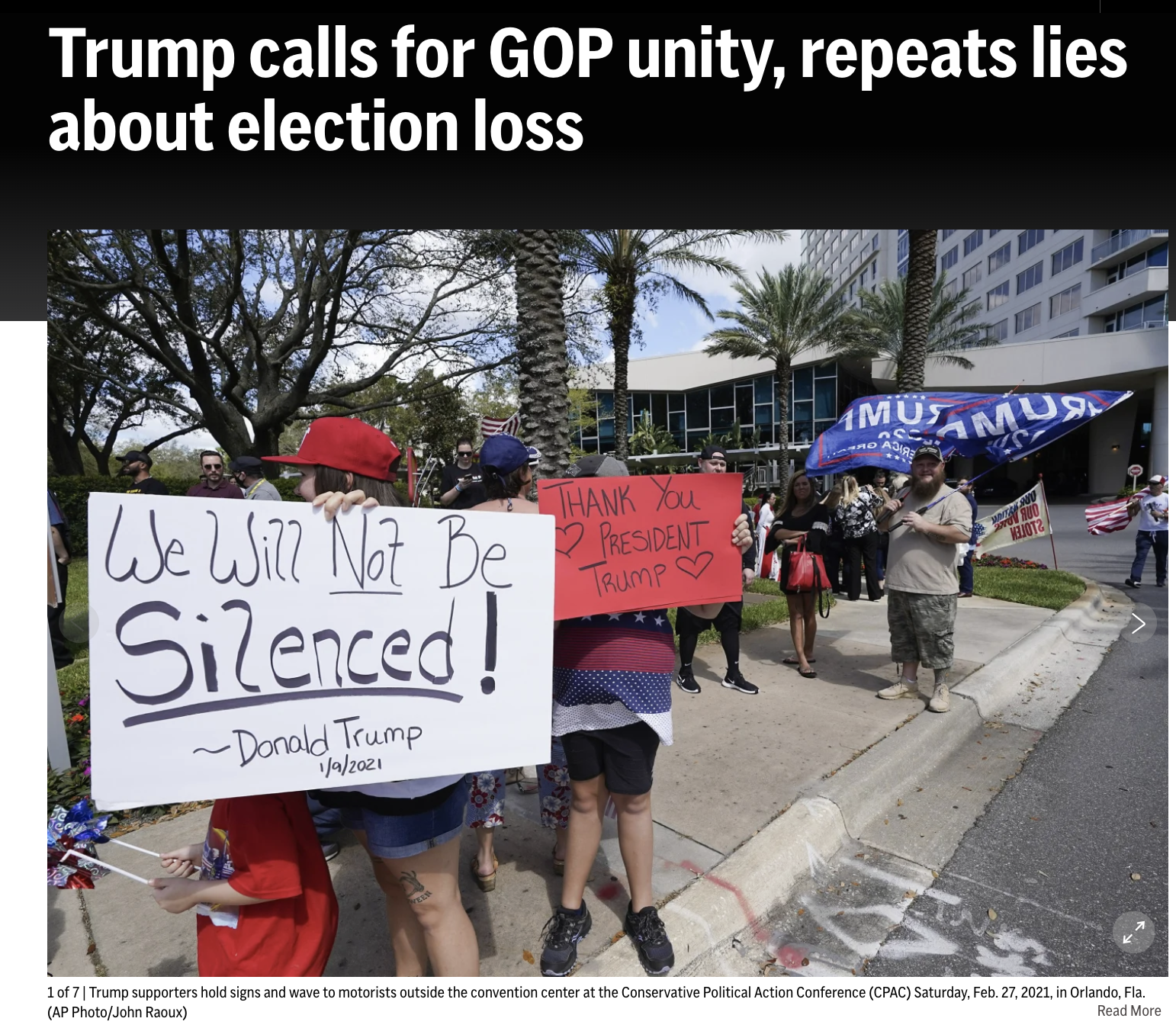
The Associated Press, also known as the AP, is a non-profit news organization started in 1846. It was created by five newspapers to share the costs of reporting on the Mexican-American War. Unlike traditional news outlets, the AP reports news through a collective effort to supply other outlets with information. The AP has won 59 Pulitzer Prizes and has 235 news bureaus worldwide.
Although the Associated Press has been an established provider of news for almost two centuries, it is important to examine possible biases. According to Biasly’s Media Bias Chart, the AP is considered a “Somewhat Liberal” or “Slightly Left” news outlet.

Source: Pew Research
As seen by the chart from a Pew Research study, Americans find bias and unfair coverage stems more from the news outlet than the journalist. Furthermore, the overwhelming view that politics and financial interests prevent outlets from being neutral is concerning. Such findings add to the importance of analyzing bias in the news. In this article, we will analyze the content the Associated Press publishes and explore possible biases in their reporting.
How Does Biasly Rate News Sources?
Biasly’s algorithms produce bias ratings to help provide multiple perspectives on given articles. Biasly has analyzed 200,000+ news articles from more than 3,200 news sources through our A.I. technology and team of political analysts to find the most factual, unbiased news stories.
Biasly determines the degree of political bias in news sources by using Biasly’s Bias Meter Rating, in which Biasly’s team analyzes media sources’ reliability and bias and produces three scores, a Reliability Score that measures the accuracy of media sources; an A.I. Bias Score, evaluated by A.I.; and an Analyst Bias Score evaluated by political analysts. These scores are rated based on seven rating metrics including Tone, Tendency, Diction, Author Check, Selection/Omission, Expediency Bias, and Accuracy. These metrics help our analysts to determine the political attitude of the article.
Our A.I. machine-learning system employs natural language processing and entity-specific sentiment analysis to examine individual articles and determine their bias levels. By analyzing the key terms in an article such as policies, bias phrases, political terminologies, politicians, and their nicknames, the algorithms can rate the attitude of the text. Bias scores range from -100% and 100%, with higher negative scores being more liberal higher positive scores being more conservative, and 0% being neutral.
Is the Associated Press Politically Biased?
Biasly rated the Associated Press gives the AP a Computer AI Bias Score of Somewhat Liberal, a score generated by its AI-based algorithms. Biasly’s AI bias analysis focuses on the leaning of tone, opinion, and diction of the author, and, their respective tendencies. For example, Biasly’s AI rated its border control and charter school policies as Medium Liberal. It also found that many politicians on both sides, such as Barack Obama and Adam Kinzinger, were covered in a negative light.
Biasly has assigned a Somewhat Liberal score as the Analyst Bias Score. Typically, alongside the Computer Bias Score, Biasly presents an Analyst Bias Score. This score is curated based on a review of at least 15 articles by a team of analysts representing liberal, moderate, and conservative viewpoints. Different types of bias in articles, preferences for liberal or conservative politicians, and policies, all factor into generating these scores. The more articles the Biasly analyst team reviews and rates, the more precise the analyst score becomes.
Before we begin, we need to discuss bias. Bias is a natural function of humans, and we can express it both consciously and unconsciously. Bias is one of the most fundamental forms of pattern recognition in humans. This isn’t to lower the bar and say that “all things are biased,” but to explain the process in which we may come to trust certain news organizations that display patterns of coverage.
On the media’s part, there is an incentive to retain audiences, encourage them to purchase subscriptions, and rate products positively. Bias is a two-way street, people want to see news stories about things they care about, and the media needs viewers to continue their operations. This creates a positive feedback loop that influences what stories are covered and from what perspective. This also explains the actions of more liberal news organizations.
Analysis of Bias in Associated Press Online Articles
As highlighted in the study from the introduction, Americans have had a difficult time trusting that news outlets are reporting information without political biases. Among U.S. adults, 79% say that news sources tend to favor one side while 21% believe that news organizations present information fairly. There is a distinction between how news outlets and journalists are viewed in terms of possible bias. According to the study, 60% of Americans believe it is possible that journalists can put aside political biases and fairly report the news. Given this information, it is important to see the possible biases in the reporting by the Associated Press.

Source: Pew Research
When determining bias, some of the most common metrics used include Tone, Tendency, Author, Diction, and Expediency Bias, which are the primary metrics we’ll focus on below.
- Tone: This represents the attitude of the writing, formed distinctively but related to the author’s word choices or diction.
- Diction: The specific words chosen by the writer.
- Author: A metric related to the article’s author, taking into account their history of stance on issues based on past articles and social media posts.
- Tendency measures how consistently an author shows bias in their work, including factors like their tone and perspective.
- Expediency Bias relates to the immediate impression created by elements like the article’s headline, images, or summary, indicating if they favor a particular viewpoint.

Source: AP
An article we will examine is titled “Trump Calls for GOP Unity, Repeats Lies About Election Loss.” The title of the article already concludes that Trump’s statements are lies without the reader being given a chance to read the information and come to their own conclusion. The cover picture shows a few of Trump’s supporters. However, the picture and the caption are straightforward as they show support for him rather than a negative depiction that fits the bias of the article.
According to Biasly’s analysts, tone and diction were neutral and presented issues regarding bias. Throughout the article, the author adopts a harsh tone when describing the statements, beliefs, and perceptions of Trump.
“even as he exacerbated intraparty divisions by attacking fellow Republicans”
“They also repeated in panel after panel his unfounded claims that he lost reelection only because of mass voter fraud”
“even as he unfurled an enemies list”
The tone the author adopts in the article is used to show Donald Trump as an eccentric individual who tends to stretch the truth and is out to get those who are his opposition. This tone is used to show Trump in a negative light. This portrayal goes beyond Trump as the author tries to tie all Republicans into his claims. The second quote using “they” generalizes the views of conservatives as those who also believe that the 2020 election was fraudulent and should have seen Trump winning reelection.
The diction in the article also adds to bias and is seen as severe by Biasly analysts. The author uses select words to further show Trump as a person who constantly lies while generalizing Republican views. For example, the author uses words such as “exacerbated”, “unfounded claims”, and “crown himself”. Such words do not give the readers a fair chance to create their own portrayal of Donald Trump. Rather, they are only offered the author’s view: Trump exaggerates, lies, and views himself as the sole leader of the Republican party.
When it comes to authors of articles, it is important to analyze their activity online and determine if there is a possible connection to bias. Jill Colvin is an active user of social media and uses it for news reporting. She retweets the work of other journalists while also posting her own tweets which consist of links to articles. There are times when Colvin uses language in her tweets that shows an unfavorable opinion of Donald Trump.
“We’re going to be appealing this scam,” Trump says as he continues to rail against his conviction.
— Jill Colvin (@colvinj) May 31, 2024
In this tweet, her use of the word “rail” depicts Trump as an angry individual. Furthermore, her choice of using Trump’s quote where he declares his trial as a scam shows bias that appeals to left-leaning views. Similar to those with left-leaning beliefs, Colvin sees Trump as disgruntled, in denial, and in objection to actions taken against him.
News outlets can vary in bias depending on the article. For example, “High Court Expands Eligibility For Clean Air Act Exemption” shows neutral reporting by the Associated Press. The author, Jessica Gresko, explains how the case unfolded, how the decision was reached, and its implications.
“The Supreme Court on Friday said an expanded number of small refineries can seek an exemption from certain renewable fuel requirements”
“A federal appeals court had said a continuous exemption was required for an extension. The Supreme Court disagreed.”
As shown in the quotes above, Gresko reports on this case using a neutral tone and diction. There are no words used to evoke strong emotions from the reader. Furthermore, the article offers facts about the case rather than the opinions of activists who may or may not have supported the Supreme Court’s decision.
Both articles show that a news outlet can be inconsistent with its bias. As seen with the Associated Press, they publish work with left-leaning bias while also having articles that are neutral and focus on informing readers. Due to this, it is important to always pay attention to possible signs of bias from news outlets in the articles they publish.
Analysis of Associated Press News Articles
News articles are a common form of media that people use to become informed on issues. With social media, new articles spread faster than ever. Due to this, it is important to analyze possible biases in news articles that the Associated Press publishes. For example, the AP published, “Biden Celebrates Pride Month, Highlighting LGBTQ Rights.” The author explains how Joe Biden has committed his administration to promoting and protecting the rights of LGBTQ individuals. It included quotes from people such as Press Secretary Karine Jean-Pierre who talked about their experiences as part of the LGBTQ community.
In another article, titled, “AR-NORC Poll: Most Say Restrict Abortion After 1st Trimester”, the Associated Press discusses abortion, a sensitive policy topic in America. Using polling numbers from the Associated Press’ Center for Public Affairs Research, the article says that 65% of Americans believe abortion should be illegal in the second trimester while 80% believe it should be illegal in the third trimester as well. After presenting these numbers, the AP included statements from three individuals. Michael New and David O’Steen are considered pro-life figures while the third individual, Dr. Daniel Grossman, is pro-choice.
Both articles show that the Associated Press is willing to report on topics that are among the most controversial and sensitive in American society. Their ability to include both sides of an issue, as seen in the second article, shows an attempt at reducing bias. However, excluding statements from those opposing Biden’s actions in the first article demonstrates that work still needs to be done. Such omissions explain the AP’s Somewhat Liberal rating by analysts.
Who Owns the Associated Press?
The Associated Press is a not-for-profit company and is considered a cooperative, unincorporated association. Currently, its chairman is Steven R. Swartz, and its president and chief executive officer is Daisy Veerasingham. It is governed by a board of directors which is currently chaired by Garcia C. Martore. Martore was the former CEO of Tegna, a large American company specializing in broadcasting. The Associated Press is not owned by an entity. Rather, it is owned by the news outlets who use its services.
Due to the nature of the ownership, it is somewhat clear to see why the Associated Press received a Somewhat Liberal score from Biasly analysts and a Somewhat Liberal score from the A.I. As a collective effort of news organizations to gather information in one place, it is possible for the AP to report news without bias most of the time. However, there are still times when bias can find itself in the AP’s reporting.
How to Evaluate and Uncover Bias
It can often be difficult to tell if the news you watch is biased. If you have settled on a news channel, it’s usually because you trust the information you are gaining. Unfortunately, many trust the information they are hearing because it confirms what they already believe. This is referred to as “confirmation bias.” It is important to challenge your beliefs and get third-party verification that what you are hearing is the full story. This is why we recommend using Biasly to compare different news stories side-by-side using our bias ratings to figure out what both sides think of a political issue.
The appearance of bias in news can vary depending on the author or objective of the article.
The Associated Press represents both sides of news reporting. Although Biasly rates the Associated Press as Center, there are instances where the Associated Press has shown it can publish left-leaning articles. The changes in bias are why it is important to use Biasly’s News Check to see if an article provides accurate and unbiased news.























